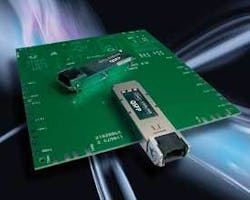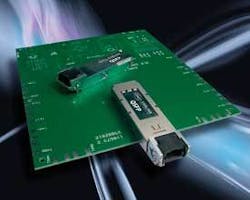QSFP market evolves, first products emerge
by Meghan Fuller
The quad small-form-factor pluggable (QSFP) is a full-duplex optical module with four independent transmit and receive channels. It is designed to replace four single-channel SFPs in a package only about 30% larger than the standard SFP. The device supports data rates of 100 Mbits/sec to 10 Gbits/sec and, like its single-channel counterpart, includes digital diagnostic capabilities to monitor link performance. Even though the first commercial devices have emerged only in the last nine months or so, the QSFP already boasts an interesting history.
The QSFP was developed to enable higher-density applications. Historically, systems designers were limited by the real estate across the front panel of their chassis. Using standard SFPs or 10-Gbit/sec XFPs, they could only accommodate so many ports before they literally ran out of physical space. QSFPs were designed to fit more transmitters and receivers into a smaller amount of space.
Originally conceived by Cisco (www.cisco.com), the QSFP initially targeted the SONET/SDH space. The typical SONET system is designed from the backplane out; the backplane supports a certain bandwidth, and the line cards follow suit. For example, a SONET system with a 10-Gbit/sec backplane might be designed with four ports of OC-48. Or it might support a separate line card designed with 16 ports of OC-12. In theory, the system also could support a line card with 64 ports of OC-3. And herein lay the problem: System designers couldn’t accommodate 64 ports of OC-3 because they couldn’t fit that many transceivers across the front panel of the chassis. The QSFP, therefore, originally was designed to be a smaller, denser form factor for OC-3.
But the device has evolved since then, molded, in part, by the companies that eventually formed the QSFP multisource agreement (MSA). Rather than singlemode-fiber-based SONET applications, the QSFP began to emerge as a key technology for multimode-fiber-based applications like Gigabit Ethernet, Fibre Channel, and InfiniBand. Many of the MSA member companies are vertical-cavity surface-emitting laser (VCSEL) or parallel VCSEL suppliers, and they have helped drive the QSFP in the direction of multimode applications. (MSA members include Avago Technologies, Beam Express, Emcore, Emulex, Fiberxon, Finisar, Force10 Networks, Helix AG, JDSU, McDATA, Merge Optics, Molex, OCP, Opnext, QLogic, Picolight (since acquired by JDSU), Reflex Photonics, The Siemon Co., Tyco Electronics, Xloom Communications, and Zarlink Semiconductor.)
For their part, the systems vendors already had begun to back away from the use of QSFP transceivers for SONET/SDH applications over concerns about field replacement. Unlike the traditional Y-pluggable transceiver with a connection that is perpendicular to the board, the QSFP is Z-pluggable-the industry’s first, according to the QSFP MSA. The QSFP’s connection is made parallel to the surface of the board, perpendicular to the back of the chassis.
“The Z-pluggable basically changes the paradigm so that once the board is plugged in, you can actually hot plug or unplug the transceiver,” explains Jugnu Ojha, strategic marketer with Avago Technologies (www.avagotech.com). “With hot pluggability, you have the option of taking a channel out and replacing it without taking the whole system or the whole card down.”
But this flexibility actually makes carriers uneasy. If you have four independent channels carried on a single optical module and one of those channels fails, you have to take down the other three, which are potentially running live traffic, and replace the entire QSFP. But for an application such as InfiniBand, which was designed as a parallel protocol from the start, field replacement is not a prohibitive issue. Further, while the QSFP originally was designed to support four independent channels, InfiniBand typically specifies a single link. A 4×InfiniBand link transports traffic from point A on one chassis to point B on another, with all the traffic moving from the same source to the same destination. Effectively, it is treated as one link, but it is physically parallel because it is easier to transmit 4×5 Gbits/sec than it is to transmit one 20-Gbit/sec link.
Vidya Sharma, vice president of marketing at JDSU (and formerly at Picolight), admits that most of the InfiniBand applications he sees today are still copper based. “But as distances are a little bit stretched, we will see more fiber deployments, which can be addressed with SFP or QSFP, depending on the data rates,” he says.
So while there is nothing in the MSA to prevent its use in singlemode applications, the clear trend today is to use QSFPs for multimode fiber links that support the InfiniBand, Fibre Channel, and Gigabit Ethernet protocols, among others. And the module vendors say the multimode applications represent a sizable enough market.“There is a need to connect chassis together, whether it’s a supercomputer, very high-end commercial computer, very large router, or optical crossconnect,” says Ojha. “Within that system, when the system spans multiple racks, you need a way to move data around, regardless of protocol. In fact,” he notes, “people use proprietary protocols over parallel optics all the time. The point is that you need to move data around in large chunks and more densely than you could with single-channel transceivers.”
To date, only a handful of QSFP devices are commercially available, and those tend to top out at 5 Gbits/sec. As one module manufacturer noted, the industry is only seven months removed from the signing of the MSA back in December 2006. Moreover, it was only after receiving feedback from the public review that MSA members decided to increase the data rate specifications from 5 Gbits/sec to 10 Gbits/sec.
Nevertheless, there are devices now on the market. Zarlink Semiconductor (www.zarlink.com), for example, currently offers 4×2.5-Gbit/sec and 4×5-Gbit/sec QSFP transceivers for InfiniBand applications. The device reduces edge and board density by 60%, say company representatives, and power consumption is reduced to 250 mW per transceiver channel to simplify heat management. Zarlink says it is developing a QSFP product family for additional applications, including the Gigabit Ethernet and storage markets.
Quebec-based Reflex Photonics (www.reflexphotonics.com), meanwhile, has officially unveiled its QS-X04-C00501 QSFP transceiver, which features four channels of 5 Gbits/sec each for an aggregate bandwidth of 20 Gbits/sec. The QSFP supports distances up to 300 m, depending on fiber type and data rate, says the company.
And Emcore (www.emcore.com) has launched its family of QSFP devices for both optical (QTR-3600) and copper (QTR-3700) media. Like the QS-X04-C00501, Emcore’s optical device supports a 4×5-Gbit/sec implementation. The company touts the device for use in enterprise data centers, high-performance computing, and telecom central offices for extending bandwidth in-system or interconnecting between systems.
The folks at Opnext (www.opnext.com) have yet to announce a QSFP product, but senior product marketing manager Josef Berger confirms that some of the company’s customers have expressed an interest in such a device. That said, he also notes that some customers are simply not interested at all-which seems to be an apt characterization of the niche as a whole.
“There are some applications,” says Berger, “but it’s not going to be a replacement for a whole market, like SFP or SFP+. At 10 Gbits, for example, the next form factor would be SFP+. QSFP will definitely not displace or prevent SFP+,” he asserts. “There are some people who will use QSFP, but it is not something that will completely change the market.”Meghan Fuller is senior editor at Lightwave.

